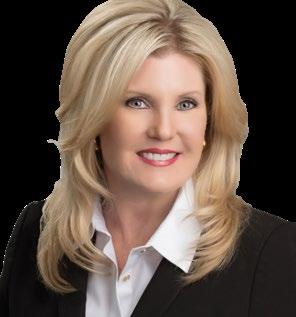

The Search for Quality Care
In the age of price transparency, more selfinsured employers are trying to steer health plan members to top performers
Get the peace of mind and support it takes to self-fund your healthcare.
Self-insuring your healthcare benefits can open up new possibilities for your business — affording greater flexibility in how you manage your healthcare spend. Trust the expert team at QBE to tailor a solution that meets your unique needs.
We offer a range of products for protecting your assets, your employees and their dependents:
• Medical Stop Loss
• Captive Medical Stop Loss
• Organ Transplant
We’ll find the right answers together so no matter what happens, your business is prepared.


By Bruce Shutan
Written By Bruce Shutan
Written By Anothny Murrello

By Laura Carabello

The Search for Quality Care
In the age of price transparency, more self-insured employers are trying to steer health plan members to top performers
Written By Bruce Shutan
AllAmedical doctors have M.D. at the end of their names, but how can self-insured health plan participants determine who is good and who is bad when there’s a dearth of data on quality of care, especially for serious illnesses or procedures?
“Our philosophy always has been that if you find the best providers, even if you pay more for them overall, your costs are going to be lower because your outcomes are going to be better,” says Phil LeFevre, vice president of business development for Denniston Data Inc. (DDI). “However, when you get to the price transparency data, you find sometimes you don’t actually have to pay more for them because there’s no correlation between quality and price for the negotiated rates by the PPOs.”
Brooks Goodison, president and principal partner of the Diversified Group, describes the hard part about assessing quality as being that so much of it is subjective, and legions of people do their own Internet searching. He says another issue to consider is that a perfectly good physician could have abysmal online reviews because of bedside manner or other factors that stray from gathering empirical evidence.

COMPOSITE RANKINGS SCORE
One serious challenge in healthcare is the absence of a metric that indicates whether something actually went well. “We know if it went poorly with adverse events,” LeFevre says. "But how do we know whether somebody’s recovery from a knee replacement was good and the surgery was done well? What the literature led us to is that practice makes perfect in healthcare, just like it does in everything else." In other words, volume experience is the best proxy for quality.
With this in mind, DDI developed a composite ranking score that measures doctor performance relative to the experience of their peers. The data and assumptions are then back-tested against adverse events such as mortality, readmission and reoperation.
While many health plans were accustomed to ranking doctors based on adverse events, they were not risk-adjusting the data. LeFevre says it’s reasonable to expect that those who treat a higher-risk population, lower socioeconomic status, higher comorbidities, confounding factors and chronic health issues are going to have higher adverse events.
A review of the medical literature, however, will provide meaningful insight for the giant cohort of doctors whose adverse events are low and similar to those of their peers. DDI conducts a comprehensive review of PubMed, which comprises more than 38 million citations for biomedical literature from MEDLINE, life science journals and online books. Another key component is to examine what constitutes good outcomes in healthcare, including speeding up a patient’s return to work.
“The transparency and coverage data that we bring in for smart scoring is massive,” LeFevre says, noting that the data set contains hundreds of billions of lines of information. “When we create a composite ranking score for a doctor, it’s okay if that takes time because then it sits in our application where the end user can find it.”
What would make the process more efficient is to calculate a smart score that measures quality, which is fixed based on annual scores, against the dynamic price that is changing from month to month in published machine-readable files (MRF). The biggest challenge is “being able to manage the size and complexity of these files and have real-time responses across hundreds of billions of lines of data,” he says.
MATCH, MEASURE AND MONITOR
The overarching goal is to match, measure and monitor patientdoctor relationships to ensure access to the highest quality of care that provides value to all key stakeholders, observes Jaqueline Oliveira-Cella, CEO and founder of wellBe Consulting.
For example, providers who won’t prescribe a GLP-1 for weight loss without also holding their patients accountable for committing to lifestyle changes involving exercise, nutrition and behavior therapy will be a good match. Those who write such scripts in a vacuum without such guardrails will be a poor match.

The next step is measuring metrics that matter, including anything from hospital readmission rates, surgical site infection rates and risk-adjusted mortality to presenteeism and workplace safety. “When you use that mix between claims and outcomes, as opposed to online reviews, you are actually
Jaqueline Oliveira-Cella
Phil LeFevre
Mayo Clinic provides the right answers with the right care
Complex is costly. Did you know that, on average, 1% of employees account for 30% of overall health costs2? This is often due to complex, misdiagnosed or undiagnosed medical conditions.
The Mayo Clinic Complex Care Program helps employers simplify the complex, by providing quick and easy access to the top-ranked hospital in the world. Our collaborative approach to medicine helps minimize costs and frustrations by identifying the right patients and delivering the right diagnosis and care.

providing something of value,” she says.
Finally, there’s a need to continue monitoring and refining this formula, finding ways to keep improving processes and embracing new technologies. The tricky part with employee benefits is achieving accountability through performance guarantees or other strategies, she suggests. A related issue is holding pointsolution providers accountable for showing their worth year after year rather than simply making promises to deliver evidencebased care.
TECH TOOLS AND DATABASES
When it comes to leveraging advanced technology to help identify high-quality providers, Oliveira-Cella cites as an example IBM Watson Health, which offers AI-powered solutions to help improve patient care, drug discovery and overall healthcare operations. She also has seen strong metrics from Quantros, whose quality division was acquired by Healthcare Bluebook in 2021 and is the nation’s largest healthcare quality-cost database, as well as Embold Health, which specializes in price transparency. Other helpful resources for raising the bar on providing quality measures that she cites include the National Committee for Quality Assurance and a free public resource from the Centers for Medicare & Medicaid Services called Care Compare.
In addition, there’s the Agency for Healthcare Research and Quality, National Quality Forum, The Joint Commission and Utilization Review Accreditation Commission.
Diversified Group uses a service that scrubs and scours through MRFs for cost data, along with a proprietary tool that the vendor uses to categorize quality.
“It’ll rank order the cost of each provider as part of a pro score,” Goodison reports. “It does a reasonably good job of presenting the data in a way where the member has some indications of cost and quality combined. So, it’s not like you’re just encouraging them to go to the lowest cost provider without any cost metrics associated with it.”
The difficult part is deciphering just how reliable the data is from cumbersome MRFs, whose format has drawn collective groans across the industry. Members who use this tool can be rewarded with cash or gift cards for making choices that are advantageous to the plan, while employers also can set up cost-sharing arrangements to steer covered lives to high-quality, low-cost providers. Another program Diversified Group is investigating is Helm Health, which offers employers variable copay options.
While Goodison sees a growing number of brokers and consultants easily captivated by bright, shiny and glittery point solutions, execution and results are key. "I see so many programs that people want that are just slapped on, and then at the end of the year, the only thing they have to show for it is the money they paid, but not a lot of results," he observes.

Goodison is concerned about so-called healthcare deserts where people have little or no access to primary care, mental health, hospitals or pharmacies for various reasons. One could be that they involve rural areas with tiny populations. In other cases, doctors in the network directory may not be accepting new patients, or comorbidity factors may complicate treatment.
Both such scenarios happened to a 70-year-old plan participant from a client in northwest Massachusetts who was considered a valuable employee with seniority. The trouble was that he was reluctant to ask for assistance and was in chronic knee pain.
Brooks Goodison
Diversified Group turned to UCM Digital Health, whose solution avoided barriers of entry for this gentleman, who was eventually prescribed medication to lower his blood pressure enough so that an orthopedic surgeon was able to take care of his knee.
LEVERAGING VENDOR PARTNERSHIPS
Finding quality doctors is top of mind for Julie Mueller, CEO and principal of Custom Design Benefits. She recently did a town hall-style presentation on this topic to consider for the TPA's roughly 35,000 health plan members. "We do all the pre-auth, case management and population health management inhouse and have nurses on staff, so we see this as an extension of that service," she explains, noting that it would be built right into their benefits package.

Having already addressed the unit cost structure with referencebased pricing (RBP) for 13 years, Custom Design Benefits was
ready to examine the other piece of the equation, which is ensuring that health plan members schedule visits with providers who have the best clinical outcomes.
Her hope is to find the right software system to help health plan members find the best doctors in their area. In the meantime, Mueller has spoken about this to all of her major vendor partners, some of whom already have components of the approach in place but haven’t taken it yet to an app model that patients could access or a website that could integrate into other service lines.
Two of those players whose solutions could be combined to help steer members to higher-quality providers include Zelis and Payer Compass. The latter company, which Zelis acquired in 2022, offers red, green and yellow quality ratings of providers who are accepting RBP.
“We’re just trying to bring some true data to the table,” Mueller explains, noting the lack of reliable individual physician data and adding that “we’re not quite there yet.”
Bruce Shutan is a Portland, Oregon-based freelance writer who has closely covered the employee benefits industry for more than 35 years.

Advocacy in Action
Legal services and innovative technology combined to defend health plans, plan sponsors and member participants nationwide
aequum advocacy programs & services successfully resolve surprise billing and unreasonable out-of-network and balance billings

Efficient Claim Resolution
On average, aequum resolves claims within just 244 days of placement.

Unmatched Savings
aequum has achieved a remarkable 95.6% savings off disputed charges for self-funded plans.

National Expertise
aequum has successfully handled claims in all 50 states.
Julie Mueller
When Healthcare Works as ONE, Patients, Payers, Providers,
and Plans Win.
Gauging Employer Support for In-Vitro Fertilization Coverage
Written By Laura Carabello
SShocking
news in mid-May of a terror attack on a reproductive medicine clinic in Palm Springs, CA, certainly boosted the issue of fertility benefits to the top of everyone’s in-box. Stakeholders throughout the country read about the heinous action of a “pro-mortalist” and his accomplice who oppose procreation and population growth..
Debates surrounding the bioethics of embryos had already reached a fever pitch earlier in the year when the Alabama Supreme Court ruled that couples who were trying in-vitro fertilization (IVF) and lost frozen embryos in an accident at a storage facility could sue under the state’s wrongful death law.
IVF STATS

• IVF is a procedure in which an egg is fertilized outside of a woman's body, and the procedure now accounts for approximately 2% of births in the United States -- over 95,000 babies annually.
• On July 25, 1978, the world welcomed Louise Brown, the first baby born through IVF.
• IVF cycles increased this past year, with 432,641 cycles performed. The percentage of singleton births from IVF cycles remains high at 96.74%.
• Because their eggs are usually of superior quality, women under 35 have an average IVF success rate of 40% to 50% per cycle. The success rate drops to about 30% to 35% for women between the ages of 35 and 40, and to about 10% to 15% for women over 40.
• IVF is also utilized in women who desire to preserve their fertility, such as women with cancer or other illnesses that may need to undergo treatments that pose a threat to ovarian function.
• The US Assisted Reproductive Technology (ART) health sector is expected to reach a value of US$4.7 billion in 2025 and expand to US$14.98 billion by 2032, progressing at a robust CAGR of 18.01% during the forecast period from 2024 to 2032.
Sources: American Society for Reproductive Medicine (ASRM); Society for Assisted Reproductive Technology (SART); RESEARCH & MARKETS

David Adamson, MD, and CEO, ARC Fertility, observes, “Some major societal shifts have sparked interest in reproductive health, especially among employers. Politics have played a key role, putting reproduction front and center and making people talk about the issue -- a topic that most people don't really want to talk about.”
With so much exposure and partisanship around this subject, he says extending these discussions opened up a whole new arena of discussion for employers around embryos and people trying to get pregnant.
“Most employers didn't have much knowledge, or they weren't very prepared to talk about it,” he continues. “But almost everybody could relate to trying to create a family, and many, many people could relate to having difficulty getting pregnant. Now, we’re finally talking about IVF and fertility care.”

Source: 2025 ARC Fertility
Many healthcare payers do not cover IVF, with estimates that only a quarter of employers report coverage of IVF for their employees. But the White House has dedicated considerable attention to mandating coverage of IVF and support for family-forming benefits, as industry concerns quickly arose about IVF transitioning from niche to necessity. Under consideration is expanded insurance coverage for IVF to all US military personnel, veterans and federal employees, while just a handful of states require some sort of coverage for IVF in state-regulated insurance plans.
David Adamson

Source: 2025 RESOLVE. The National Infertility Association
The administration may yet declare IVF as an “Essential Health Benefit” — and extend coverage to the nearly 50 million Americans insured through the Affordable Care Act. At the same time, the government could push Congress to pass a law requiring private insurance companies to cover IVF procedures for any person struggling with infertility.
Since self-insured plans, as governed by federal law under the Employee Retirement Income Security Act (ERISA), are not subject to state insurance regulations, employees enrolled with self-insured plans may not receive IVF benefits unless their employer chooses to offer them.
And IVF is not inexpensive. Stanford Institute for Economic Policy Research estimates the cost at $15,000 to $20,000 for a single cycle. Many women require more than one cycle before they are able to have a baby.
Contributing to the discussion are reports that the US birth rate is steadily declining, as Macrotrends projects a 0.12% decline in 2025 from the previous year. There are various estimates on the extent of infertility, as the World Health Organization states that infertility now affects roughly one in six women of reproductive age, and the White House contends that as many as one in seven couples trying to have a baby are unable to conceive.
Self-insured employers must now weigh their options for providing benefits that cover this medical procedure, which assists couples and individuals in conceiving a child. RESOLVE, the national infertility association, says that patients deserve policies that:
• Acknowledge all family-building options
• Adopt an inclusive definition of infertility
• Align with current clinical guidelines and scientifically supported standards of care
• Ensure bodily autonomy, free from government intervention
• Honor the Doctor-Patient relationship
• Respect all the ways families are built and created
LOOMING MANDATES
Back in February, President Trump announced the administration’s intent to increase access to IVF by easing unnecessary statutory or regulatory burdens to make IVF treatment drastically more affordable. The executive order states that Americans need reliable access to IVF and more affordable treatment options.
It advocates for providing support, awareness and access to affordable fertility treatments to help these families navigate their path to parenthood with hope and confidence. A formal list of policy recommendations is expected soon to reiterate the executive order to protect “IVF access and aggressively reduce out-of-pocket and health plan costs for IVF treatment.”
As plan sponsors await these policy recommendations, they should continue to evaluate the cost implications associated with IVF coverage along with value considerations related to comprehensive family-forming benefit packages best suited to their population.

Source: www.healthinsurance.org
The push toward a holistic fertility policy and expansion of IVF access for the general public will likely require legislative action, although the administration could take some steps on its own to expand coverage. For example, the Trump administration may focus on the high cost of fertility medications, which usually cost thousands of dollars for each cycle, and make these drugs part of an executive order calling for lower prescription drug prices. While cheaper, generic IVF drugs are available in Europe, none have been approved in the United States.

Lisa Comerose, vice president of National Clinical Management Consulting at Marsh McLennan Agency (MMA), confirms that her organization recognizes the importance of family-forming benefits and ART, including IVF.
"We believe that supporting employees in their family-building journeys is essential for their overall wellbeing and job satisfaction," says Comerose. “We are aware of the federal policy recommendations aimed at protecting access to IVF. These recommendations are crucial in addressing the financial barriers many individuals face when seeking ART services. We are committed to staying informed about these developments and evaluating how they may impact our clients.”
She says that while the recent order does not mandate changes, MMA recognizes the growing demand for comprehensive family-forming benefits.
“For example, we are continuously exploring vendors through our Vendor Innovation Council (VIC) to enhance the employer options for ART,” she continues. “The VIC is comprised of MMA’s Planning & Analytics for Total Health (PATH) team of 55+ physicians, RN-clinical consultants, and health management consultants, as well as other MMA account team members, evaluating each vendor up for consideration based on their services, capabilities, and overall performance to ensure we are bringing the best options to the table for our clients.”
She maintains that coverage of family-forming benefits is absolutely a “must-have” to recruit and maintain top-level talent in this competitive environment.
“In today's competitive job market, offering comprehensive family-forming benefits, including ART coverage, is becoming increasingly important for attracting and retaining top talent,” says Comerose. “Employees are looking for employers who support their personal and family goals and providing these benefits can significantly enhance the value proposition of an employer.”
Many argue that these mandates are reshaping fertility benefits in the workplace, prompting employers across various industries to reevaluate their fertility benefit strategies. These policies are likely to set a powerful precedent, signaling that comprehensive fertility coverage could soon become a national standard. As more legislative efforts push for inclusive access to reproductive healthcare, businesses must proactively adapt to these changes to stay competitive and compliant.
For employers, these mandates introduce several key considerations:
• Ensuring compliance with new legal requirements, adjusting health plans to meet mandated fertility coverage.
Lisa Comerose
• Anticipating increased demand for IVF and other assisted reproductive technologies, preparing for the financial and logistical implications.
• Providing equitable access to fertility care for all employees, including LGBTQ+ individuals, single parents by choice and those pursuing alternative family-building options.
“Beyond the need for compliance, embracing these changes proactively offers a strategic advantage,” says Dr. Adamson. “Companies that take the lead in expanding fertility benefits position themselves as industry leaders in workplace inclusivity, strengthening their ability to attract and retain top talent and support employee wellness. Navigating family-building can be stressful, but these benefits ease that burden and can increase employee satisfaction and productivity. Fertility benefits are becoming a core expectation, not an optional perk.”
As employee expectations for family-forming support continue to grow, he advises that businesses that prioritize fertility coverage will not only foster a more inclusive workplace but also reinforce their commitment to employee wellbeing and reproductive equity.
“Fertility treatments can be emotionally, physically and financially taxing, often leading to stress, absenteeism and reduced workplace engagement,” advises Dr. Adamson. “By offering meaningful support through covered treatments, flexible work arrangements and mental health resources, employers can help alleviate these burdens, allowing employees to remain focused, engaged and productive while navigating their family-building journey.”
The stress and anxiety associated with ART cannot be overlooked, as Erica Djossa, CEO & founder of Momwell, shares, “Up to 60% of individuals going through IVF experience significant symptoms of anxiety or depression, and nearly 1 in 5 struggle with depression severe enough to impact their daily life.”
Djossa says the emotional toll of IVF is profound, often accompanied by uncertainty, grief, physical demands, and a lack of support.
“At Momwell, we’re working to ensure that mental health is recognized and integrated as an essential part of fertility care,” says Djossa. “Through our partnership with ARC Fertility, we’re helping individuals feel seen, supported and emotionally equipped to navigate every step of the journey."
EMPLOYER IVF COVERAGE GAINS TRACTION

As employers compete for top talent, offering comprehensive fertility benefits is essential. While many states mandate some form of fertility coverage, these mandates often have significant limitations and do not apply to self-insured employers.
To attract and retain diverse talent, companies are now designing benefits packages that include coverage for Assisted Reproductive Technology (ART), fertility treatments or procedures such as IVF, as well as a broad range of services, including surrogacy and egg freezing. These initiatives ensure that all employees, regardless of marital status, sexual orientation or age, have the opportunity to build the family they envision.
Erica Djossa
Mercer’s 2024 National Survey of Employer-Sponsored Health Plans reported that 47% of large employers with 500 or more workers covered IVF, up from 45% the previous year. Among the largest employers (those with 20,000 or more workers), 70% provide coverage for IVF, an increase from 62% the year before.
Dr. Adamson adds, “By embracing evolving standards, businesses invest not just in their employees' family-building journeys, but in their own long-term success. Comprehensive fertility coverage is no longer just a competitive advantage. It is becoming a fundamental component of talent retention and recruitment strategies.”
He points to research showing that 88% of employees would consider changing jobs for better fertility benefits, underscoring the growing demand for comprehensive reproductive healthcare. By offering IVF coverage and other fertility services, employers can differentiate themselves as industry leaders in employee wellbeing, ensuring they attract and retain top talent in a competitive job market.
Dr. Adamson counsels employers that offering comprehensive reproductive healthcare does not have to be cost-prohibitive, explaining, “With strategic planning and innovative cost-saving measures, companies can increase access to care that is both affordable and high-quality, ensuring employees receive the support they need without excessive financial strain.”
He points to several effective approaches that enable businesses to stay competitive, support workforce wellbeing and foster a more inclusive workplace:
• Adopting packaged or bundled payment plans that allow employers to cover multiple IVF cycles at a negotiated rate. This method reduces financial risk while increasing the likelihood of successful treatment outcomes with more patient-centered and cost-effective care.
• Implementing a pay-as-you-go model. Instead of flat fees per employee, some companies opt for on-demand fertility coverage, meaning they only pay for treatments when they are actually used. This approach aligns employer spending with actual demand, making it a financially sustainable option for organizations looking to provide fertility benefits without unnecessary upfront costs.
• Partnering with specialized fertility networks can help employers lower costs while ensuring that employees receive evidence-based, high-quality care. These collaborations streamline treatment plans, provide discounted services and grant employees access to top-tier reproductive specialists, enhancing both efficiency and affordability.
Employers considering adding coverage for fertility benefits might be surprised that companies can offer these benefits with minimal additional cost to their medical plans. Including family-forming benefits may even reduce healthcare costs, as a study from the American Society for Reproductive Medicine compared states with insurance coverage mandates for IVF to states without such mandates.
The researchers found that people who lack access to fertility coverage or have limited coverage may try to save out-of-pocket costs by avoiding certain screenings or transferring multiple embryos to maximize their chances of successful implantation. But these cost-cutting measures increase the risk of multiple births, high-risk pregnancies or miscarriage. Covering fertility benefits can lead to safer pregnancies, fewer






IS OUR POLICY

Covered Employer Stop Loss claims are reimbursed quickly and accurately. CLAIMSISOURPRODUCT® and we have the stellar financial strength and industry-leading Employer Stop Loss team to consistently do what's right for our customers - and do it fast. So you get balance sheet protection, with certainty.

multiple births, healthier babies and less time spent in the NICU because parents are making decisions based on medical best practices instead of out-of-pocket costs.
ELEMENTS OF COST AND EFFICIENCY
Many employer-sponsored plans fail to offer standard coverage for the complex medical procedures and specialty medication associated with the IVF process, creating a significant expenditure for couples facing infertility. Typically, IVF is covered under the medical plan, although employers have the option to carve out this coverage to a vendor that provides specialized fertility benefit administration, network management and access to advocates and clinical resources. Select vendor solutions are designed to manage the cost of the care being delivered, educate recipients and members and help ensure optimal care outcomes.
According to the International Foundation of Employee Benefit Plans (IFEBP), more than 40% of employers now offer some form of fertility benefit, and that number continues to grow. In addition, 37% of employers offered paid adoption leave in 2024, signaling a broader shift toward family-forming support.
Advisors at Mercer point to several important considerations in designing a benefit:
• Benefit limitations Given the high cost of fertility services, nearly all employer health plans include lifetime benefit limitations to put parameters around the cost to the plan. These are typically dollarbased limitations (used by 54% of large employers providing IVF coverage) or limits on the number of cycles covered (used by 23%).
Given the variability in the specific services that a member may require, cycle-based designs offer members the flexibility to access clinically relevant services as needed without risking running out of coverage mid-cycle. According to our survey, the median number of cycles covered is three. Conversely, dollar-based designs allow employers to more accurately budget for their program costs while still providing access to care. The median lifetime dollar limit is $20,000, which falls short of the typical cost for a single IVF cycle.
• Pharmacy costs Specialty pharmacy costs related to IVF can account for a significant portion of the total cycle cost, sometimes as much as 40%. Coverage for these medications can be provided either through an employer’s pharmacy plan or carved out to a specialty fertility vendor. Regardless of the administration method, it is important for employers to understand what may drive variability in their fertility pharmacy costs, such as rebates, discounts and waste management practices. These variables can impact the extent to which the lifetime benefit maximum covers the total cost of treatment.
• Quality of care Perhaps most importantly, employers must consider the quality of the care that members can access. High-quality care, with providers that follow evidence-based medicine to develop clinically relevant, individualized treatment plans, may help members achieve their desired outcome more quickly with the fertility coverage available, while also minimizing the risk of downstream costs for complex newborn care.
While a medical plan network may include quality providers, specialty fertility vendors often function as centers of excellence, developing exclusive fertility provider networks that measure cost and quality of care delivered and providing care navigation within the network. Some vendors achieve outcomes that outpace national averages for clinical metrics reported by the Society for Assisted Reproductive Technology.

Mercer offers these guiding principles for employers:
• Aim to offer at least a full cycle of care, whether through a dollar-based or cycle-based benefit design
• Provide equitable access to comprehensive fertility coverage
• Ensure members are accessing high-quality care
AN IMPORTANT ROLE FOR BROKERS
With growing demand for employer-sponsored family-forming support, brokers have an opportunity to add real value to their benefits consulting services by helping their clients shape program offerings that meet evolving employee expectations. The employee benefits renewal season is an ideal time to proactively ask clients if their employees have inquired about family-forming support.
Courtney Hutchison, CEBS, market president, The MJ Companies, says that as an independent employee benefits broker and advisor, her firm often recommends that its clients add coverage for these services via their employee benefit programs.
"We first must ensure our clients' philosophies are aligned with the nature of these services and that supporting family forming benefits broadly are aligned with the strategic direction of each employer," she explains. "When there is alignment, these benefits are an effective way to ensure a comprehensive suite of benefits coverage for employees. We assist our clients in designing and managing their employee benefit programs, including, but not limited to, coverage options for ART."
As family forming benefits continue to be a top area of focus for employers, as both a recruitment and retention component, Hutchison says it's important to remember that family forming benefits cover a wide spectrum of services, from fertility treatments to surrogacy to hormone replacement therapy during menopause.

“It is also common for an employer to cover only a subset of services in this broad category and/or to enforce coverage limits - all while ensuring alignment with their organizational philosophy and budget constraints,” she notes.
As independent employee benefits brokers and advisors, the associates at Hutchison's firm are regularly engaged in strategic conversations with their employer clients about the role family forming programs may play in a broader total rewards strategy.
“We conduct vendor analyses on behalf of our clients and partner with a variety of family forming vendors and service providers to deliver these programs,” she says.
At MMA, Comerose points to the roles of the organization’s Chief Medical Officer, RN Clinical Consultants,
Courtney Hutchison
Health Management Consultants, and compliance who can provide the necessary resources.
“Additionally, our Planning & Analytics for Total Health (PATH) provides our clients with the necessary data analytics and clinical support to provide insights into family-forming benefits and utilization,” she explains. “Brokers, TPAs, and benefits consultants should indeed be prepared to provide guidance on these resources. They play a vital role in helping organizations understand the complexities of benefits offerings and ensuring that employees have access to the information and support they need. We encourage collaboration with these partners to ensure that employees receive comprehensive assistance regarding familyforming benefits.”
A NEW ERA OF FERTILITY BENEFITS
The introduction of legislation represents more than just policy changes – it is a catalyst for a national transformation in employer-sponsored fertility benefits.
These statutes portend massive changes: notably, SB 729 in California that expands fertility insurance coverage, requiring large group health plans to cover infertility diagnosis and treatment, including IVF, along with H.R. 2828, requiring Federal employee
health benefit plans to include assisted reproductive treatment benefits.
Throughout the industry, there are high expectations that other states will consider similar legislation to California's law, given the increasing recognition of the importance of accessible family-forming options. A clear sign of the times is a new house bill -- the IVF Access and Affordability Act -- that would provide a federal income tax credit of up to $20,000 for an individual and $40,000 for a couple for fertility treatments.
A word of caution to those who champion these changes: at the time of this writing, even those who have met with White House officials say they are keeping their expectations in check, emphasizing that President Trump has yet to publicly make any concrete policy proposals.
The specifics will tell the story and help to guide employer decisionmaking on coverage for family-forming benefits.
Laura Carabello holds a degree in Journalism from the Newhouse School of Communications at Syracuse University, is a recognized expert in medical travel and is a widely published writer on healthcare issues. She is a Principal at CPR Strategic Marketing Communications. www.cpronline.com
REINFORCING THE CRYSTAL BALL OF CARE
A predictive-analytics makeover adds greater precision to anticipating highcost claims while also elevating vendor value propositions

Written By Bruce Shutan
TToday’s
sophisticated predictive-analytics models help self-insured health plans get a better handle on risk, as well as enable stop-loss carriers and reinsurers to price new business with greater precision and provide care managers with a clearer path to improving clinical outcomes.
Traditional prediction models often fall short in accounting for the nuances in healthcare journeys for members who appear similar on paper, notes Ali Panjwani, founder and CEO of Merit Medicine. For example, two patients with the same condition, comorbidities, age, gender and demographics may have vastly different treatment paths. These differences can result in a significant variance in claims spend due to several factors.
“As we leap forward into a world where data is abundant, artificial intelligence has grown in sophistication with our ability to process data through GPUs [graphic processing units), and we’re now able to actually process the individual healthcare data for every single member in a group that might be underwritten,” he says.
That granular level of detail involves examining primary, secondary and tertiary conditions for both lowand high-cost therapies, but also individual interaction with the healthcare system that tells a narrative about each patient.
UNIVERSITY


For example, his company may learn that a health plan member who was prescribed six months of a disease-modifying therapy following a hospitalization had an adverse reaction to the drug after only 30 days. Tack on a series of specialist visits to treat loss of eyesight and an injured leg through physical therapy, and the complexity deepens.
A scenario like this one draws on patterns that paint a picture of how risk would look in the coming year. Panjwani explains that deciphering the level of predicted spend allows the actuary, underwriter and stop-loss carrier to underwrite the risk of that particular member in a superior way to just using demographics and a manual rate build-up.
UNDERSTANDING PROBABILITY
Since the vast majority of employers aren’t large enough to counterbalance large claims with employees who file low-cost claims or none at all, there’s no escaping volatility and unpredictability. The challenge, of course, is how small and midsize self-insured groups can better anticipate claims when some of that volatility is random, claimants can be costly one year but not the next and employees may change every year, according to Daniel Wolsk, chief revenue officer for Claros Analytics.
In trying to anticipate unexpected cost spikes, he says the emphasis is on understanding the likelihoods of medical events occurring rather than spotting specific cases that are complicated by data-privacy concerns.


Ali Panjwani
"We're not doing anything to uncover the sick people or potentially sick people in a group," Wolsk explains. "We're trying to establish what the normal range is for the group in a much more sophisticated manner than the traditional methods or alternative mechanisms out there."
His company uses probability models to establish sound actuarial expectations based on the size and characteristics of each group, such as age and geography. Algorithms were built to leverage large data sets and computing power to deliver more precise estimates on claims risk.
The objective is to make it fast and easy for benefit brokers and consultants to help their employer groups anticipate the risks and rewards of changing a medical copay, stop-loss policy deductible or provider network, as well as implementing a medical management program to address a particular area of concern.

"We took just a completely new approach and built probability distributions around four dozen different service categories, and then we adjusted those distributions based on the characteristics of the group," Wolsk notes. "We're doing thousands of calculations because all of these different inputs are interacting with each other in different ways inside the algorithm."
MOVING THE SITE OF CARE

As the fastest-growing component of healthcare costs, prescription drugs serve as a ripe area for predictive-analytics. There are several components with respect to specialty drugs where it plays a role in how Leap Health applies its data logic and tools toward improving patient experience, site of care and clinical outcomes, explains co-founder and CEO Rob LaHayne.
On the front end, it’s about ingesting clinical and claims data, then applying patient-generated data and trying to elevate predictions across those three categories. It starts with identifying patients who are eligible for infusiontreatment services, then engaging them in a thoughtful and targeted way that drives meaningful behavior change.
The next task at hand is determining whether the patient and doctor are willing or resistant to moving the site of care from a cost standpoint based on demographic information, ZIP code and provider contract strength within the network. In some cases, that could mean safely administering drug infusions in a patient’s home. The final component is ensuring that patients are on the right drug and adhering to their regimen, which will improve outcomes.
“All of that can be solved by predictive-analytics,” LaHayne says, noting that it will generate a risk score on each of those categories. Given that his company works with specialty infusion therapies that affect only about 1% of the U.S. population, he explains that there’s a built-in need to be highly targeted.
When performing a full-blown savings analysis, Leap Health ingests client claims data from recent years before repricing and running it through analytic models that show savings opportunities. “We can predict where that trend line is going,” he says, noting efforts to turn data into action as more automation is built around the back-end data to provide more value.
Daniel Wolsk
Rob LaHayne
Leap Health was able to intervene on behalf of a patient in Washington who had been traveling about 100 miles every two weeks to receive Krystexxa infusions to treat gout. Switching the site of care saved $750,000, but also dramatically improved his quality of life with fewer disruptions to work and less time away from family. "We were able to get that patient off the drug because he was able to be more adherent to the plan," he reports.
COLLABORATING WITH ACADEMICS
Predictive-analytics is fertile ground for collaboration between experts in the fields of medicine and data science. One such example involves the decade-long evolution of Prealize Health. Matt Whitnack, the company's head of business development, credits two academics at Stanford University whose work was critical in helping build an AI-driven predictive modeling tool to better identify high-cost claimants and, as a result, bend the healthcare cost curve. They included Arnold Milstein, M.D., a professor of medicine who directs the school's Clinical Excellence Research Center, and Nigam Shah, Ph.D., who heads up the bioinformatics department and is also chief data scientist for Stanford Health Care.
Ten years ago, the professors noticed that 7% of today's patient population will incur 34% of next year's cost. "They used a very large offshore claims data set to do all the building and testing that led to the development of their first successful machine learning model," Whitnack explains. "They gave that model to us, and that was the catalyst for starting our company."
Prealize built out roughly 50 other machine learning models that produced highly accurate predictive insights to augment care and condition management to help payers find new high-cost claimants. The



company later moved into underwriting and providing higher accuracy cost predictions to price renewals with more precision. It also launched a solution to help risk-stratify potential new groups that includes a 300 million-plus member claims data lake.
After focusing on fully insured plans and administrative-servicesonly contracts, Prealize took its solution into the self-funded space. The goal was to help stop-loss carriers find good targets and price premiums more accurately based on better risk scores and deeper insights into the risk. The solution goes beyond risk scores in that it includes threshold predictions for stop-loss.
"We've brought in predictions that stop-loss carriers don't get from other solutions in the space, such as excess models that show how many members will exceed certain cost thresholds, like $100,000 and $200,000, for example, and what the excess cost is predicted to be at those thresholds," Whitnack reports. "We've layered in some explainability around what the profile of a group's risk looks like and what sort of conditions and drugs members have and how many people are going to show up in inpatient and the emergency department."
In 2023, Prealize learned about the so-called healthcare transformer model being developed at Stanford University. The transformer model is based on the same AI model that powers large language models like ChatGPT and Gemini. It partnered with Stanford to develop its own health-care transformer model and found that it provided a lot of benefit over previous-generation machine learning models, including
even higher accuracy. Training the model involves feeding it claims information that the model uses to build a healthcare timeline of medical and Rx events on each individual in the training set.
"You have every healthcare event and drug event in a timeline for each member, and then we drop some of those events out of the timeline, and we teach the transformer model how to fill in the correct events," Whitnack says. "That's similar to how ChatGPT is trained, except that model is fed."
Prealize built a new framework around the transformer model that allowed it to move away from operating 50 independent machine learning models to operating a single foundation model for each client. The foundation model enables the company to quickly add highperforming new predictions in only two months, compared to the eight to 12 months it took using prior-generation technology.
SPOTLIGHTING VENDOR ROI
Meanwhile, advancing technology continues to reshape the employer-provided medical benefits supply chain. Pointsolution providers are able to leverage machine learning and predictive-analytics models to demonstrate to their self-insured customers with a high degree of certainty what the costs would have been without their solution in determining a potential return on investment (ROI) and the overall value their interventions provide.

Lachelle Brown Senior Member Advocate
Since there are significant dollars in play when a carrier underwrites the risk of a group, Panjwani says it’s critically important to nail down the right details to grow a healthy book of business that produces good results. That’s because getting that risk assessment wrong means mispricing it or declining to quote altogether.
Merit Medicine’s ability to map millions of chronically ill patients in a data set helps stop-loss carriers and managing general underwriters better predict claims risk and ROI with a higher degree of certainty. Having better data that allows for a much higher degree of accuracy in determining what risks are inherent in a particular group allows vendors to avoid surprises and pricing the business accordingly.
“It’s a competitive environment to be able to win groups, and so it’s better to know the risk, price it high and lose that business vs. not know the risk, price it too low, and end up with a group that generated a lot more reimbursements than expected and a higher loss ratio,” he opines.
On the other end of the spectrum, it pays to have the right predictive-analytics in place in the event that a group appears riskier to insure than meets the eye. For example, efficacious treatments may have been acute in duration and significantly improved the condition of members who drove much of the healthcare spend in a given year.
Self-insured employers will want their carrier to price responsibly by baking into the premium the risks that exist so that year over year, there’s more predictability and risk management can be planned appropriately, Panjwani adds.



Merit Medicine has been able to use predictive-analytics to better target and stratify members of a population with highly complex healthcare needs who would have benefited most from carecoordination services. He credits the ability to acquire firstdollar pharmacy and medical claims data on demand and utilize ground-up claims data to generate the company’s output.
EYEING BETTER OUTCOMES
What’s exciting to LaHayne is the potential to dramatically improve risk stratification and chronic disease management. Mindful that 20% of any typical employee population is driving 80% of the overall cost while 1% of infusion therapy drives 15% of the tab, he notes that “these are chronic condition patients on high-cost drugs that we want to be able to segment and tie back to better outcomes.”
The aim is to establish priority tiers that factor in the cost and safety of the drug being infused elsewhere, along with the willingness of the patient and doctor to make that move. For care managers, it’s a matter of providing higher-risk patients with the tools they need to receive better care.
A superior predictive-analytics model can help specialty carriers whose mission is to improve outcomes and bend the cost curve by identifying specific problems that exist in a particular group. For example, keeping a closer watch on a particular health plan member who is

suffering from an ongoing low-back condition that might fall below the threshold of the specific stop-loss deductible in a given year could help ward off expensive claims the following year. That might mean exploring a musculoskeletal digital physical therapy solution today to better manage back pain and avoid expensive surgery.
Prealize partners with risk-taking entities such as specialty care management companies to drive improved cost containment. One example involves using predictive-analytics to spot members who are at risk for developing musculoskeletal injuries so that they can be offered much earlier assistance, such as physical therapy, find relief and potentially head off avoidable, costly surgeries.
As the old axiom suggests, any ounce of prevention that self-insured employers can bake into their plans with the help of predictiveanalytics would be well worth a pound of cure.
Bruce Shutan is a Portland, Oregon-based freelance writer who has closely covered the employee benefits industry for more than 35 years.

Lights. Camera. Seamless.


STATE LEGISLATIVE SESSION WRAP-UP FOR 2025

Written By Anothny Murrello
ThroughoutTthe year, SIIA’s Government Relations Team monitors and advocates for the self-insurance industry on a wide range of policy proposals advanced at the State level. This includes opposing efforts to enact unreasonable prohibitions on the sale of stop-loss insurance and efforts to erode ERISA’s preemption powers, while advocating for policies beneficial to stop-loss insurance coverage and captive insurance arrangements. Most of this work is done between January and May when the majority of the State Legislatures around the country are in Session.
2025 was another busy year for us, and we are pleased to report that our advocacy efforts in various State Capitols – coupled with our partnership with industry stakeholders and Coalitions – were successful in blocking efforts to prohibit the sale of a stop-loss insurance policy in certain cases, and we shortcircuited efforts to pass State laws that would have dictated how a self-insured plan should be designed and operated. We also supported efforts to promote access to a captive insurance arrangement, and we tracked State efforts to regulate Artificial Intelligence (AI).
Now that most State Legislatures have adjourned for the year, we wanted to provide you with a summary of the most relevant State legislative proposals that we tracked throughout 2025. SIIA will continue to monitor those State Legislatures that are still in Session, as well as any special sessions that may be called for, and we will keep you apprised of any relevant regulatory proposals that may be promulgated before the year’s end.
Arizona:
Regulatory
Licensure Issue
– At the beginning of the year, SIIA learned that the Arizona Department of Insurance and Financial Institutions (DIFI) had taken the position that insurance carriers issuing stoploss insurance policies to organizations sponsoring selfinsured health plans must possess a Property and Casualty License. However, for decades, SIIA members selling stoploss insurance in the State filed their stop-loss policies as a Life and Health product (not a Property and Casualty product) and only possessed a Life and Health License.

In response to DIFI’s arbitrary position, we quickly organized a group of affected SIIA members and additional stakeholders, and we engaged DIFI on the matter. We kicked off our engagement by sending a formal letter to DIFI in which we explained that our member stop-loss insurance carriers issue their policies in accordance with Arizona Revised Statues Title 20, Insurance Sec. 20-253, and they have submitted informational rate and form filings to DIFI without any previous objection to their license status. We also reminded DIFI that there is no legislative or regulatory basis for the DIFI’s position.
As a result of our letter, DIFI invited us to discuss the issue with the Commissioner’s staff and join a DIFI Life & Health Advisory Committee meeting, where we were able to further articulate our position and educate staff on how stop-loss insurance is regulated in other States. DIFI continues to study the points that we raised, and we have been told that DIFI is considering issuing a Bulletin grandfathering in those stop-loss carriers that currently do not have a Property and Casualty License. SIIA will continue its dialogue with DIFI and advocate on behalf of our stop-loss carrier members.
Status – Ongoing
Connecticut:
SB 10 – Section 10 of SB 10 would have prohibited the sale of a stop-loss insurance policy to the sponsor of a self-insured health plan if the underlying plan did not cover the ACA’s “essential health benefits” (EHBs) and the State’s Mandated Benefits. Section 10 would have also prohibited the issuance of a stoploss policy that had attachment points below specified dollar thresholds.
In response, SIIA submitted a letter explaining that we oppose arbitrary and unreasonable regulation of stop-loss insurance, including placing unreasonable dollar limits on attachment points. We also argued that

prohibiting the issuance of a stop-loss policy to a self-insured plan that does not cover the ACA’s EHBs and State Mandated Benefits was a back-door way of regulating the underlying self-insured plan, which is prohibited by ERISA’s preemption provision. And, in an effort to educate State Legislators on how ERISA’s preemption powers work, we furnished the Legislative Committee with SIIA’s White Paper on ERISA Preemption. The underlying legislation that included Section 10 was signed into law in June, but we are pleased to report that Section 10 (which included the offending language) was successfully removed from the final version of the bill.
Status – Signed into Law. (However, the offending language in Section 10 was not included.)
SB 7 – Section 14 of SB 7 would have directed Connecticut’s Health Care Cabinet to study whether a stoploss insurance policy used in conjunction with a self-insured health plan should be regulated as a fullyinsured health plan. In response, SIIA submitted a letter explaining that conducting such a study would be an inefficient use of State resources based on the fact that the Connecticut Department of Insurance had already conducted a similar study. Our letter also explained in detail how stop-loss insurance works and how and why stop-loss insurance is not “health insurance.”
Status – The bill failed to pass the Legislature and is now dead.
SB 11– Section 12 of SB 11 would have required a stop-loss insurance policy to cover the ACA's EHBs and states' mandated benefits and also would have required a minimum of $75,000 individual and $250,000 aggregate attachment points. In response, SIIA submitted a letter once again explaining how stop-loss insurance works and how and why stop-loss insurance is not health insurance. We further explained that stop-loss insurance only covers health benefits covered by the underlying self-insured plan, and if the underlying self-insured plan does not cover the ACA’s EHBs or the State’s mandated benefits, the stoploss policy cannot be mandated to cover non-covered benefits.
Bringing gene therapies to your employees while protecting your bottom line
Gene therapies are estimated to have a 42x growth in the number of potential candidates in the U.S. by the end of 2027.* As the gene therapy pipeline grows, so do the claims and financial risk for employers. Wellpoint can help you minimize that risk.
Wellpoint’s Gene Therapy Solution works as an endorsement of our stop loss policy to protect employers from unknown financial risk while providing access to life-changing therapies for rare and complex conditions. Our solution includes the Wellpoint-approved Gene Therapy Drug List with:
•Perpetual “laser-free” coverage for those gene therapy drugs listed in the Wellpoint solution once the initial underwriting is approved.
•No stop loss claims from these drugs for simpler administration. All stop loss claims from the drug list are removed from a client’s claim experience at renewal.
To learn how our Gene Therapy Solution can protect your company, contact your Wellpoint representative.
Status – The bill failed to pass the Legislature and is now dead.
Indiana:
HB 1129 – This bill would have required insurers – and self-insured health plans –contracting with third parties to include providers of care for mental illness or substance abuse services as an in-network provider if the mental health/ substance abuse provider is credentialed for medical or surgical services under the health plan. If enacted, this bill would have been preempted by ERISA and would not have been applicable to self-insured plans.
Status – The bill failed to pass the Legislature and is now dead.
Louisiana:
SB 16 – This bill would have prohibited the sale of a stop-loss insurance policy to an employer with 50 or fewer employees. The bill was being promoted by Blue Cross of Louisiana and had the support of the Governor and the Department of Insurance. SIIA worked with a group of stakeholders and Coalition partners to advocate on behalf of our members who opposed the bill. Through our advocacy, we explained that although States have a right to regulate their own insurance markets (including their stop-loss insurance market), the proposal is arbitrary and unreasonable and would significantly harm small-group self-insured plans in the State.
We are pleased to report that this offending provision was successfully removed from the final version of the bill.
Status – Signed into Law. (However, offending language was not included.)
SB 110 – This bill sought to explicitly eliminate ERISA Preemption protections from the definitions of "health insurance issuer" in the State. SIIA joined a group of stakeholders in the opposition effort, and the bill did not progress through the Legislature.
Status – The bill failed to pass the Legislature and is now dead.

New Jersey:
DOBI Report –Legislation enacted back in 2023 requiring the Department of Banking and Insurance (DOBI) to, among other things, analyze whether small employers that self-insure and obtain stoploss coverage are adversely impacting the small group market. In connection with this study, SIIA and other stakeholders met with the NJ Insurance Commissioner multiple times to discuss our concerns about any future regulation of stop-loss insurance obtained by small employers. DOBI has not yet issued its report, and SIIA will remain engaged. For example, at the request of DOBI, we will assist in developing a White Paper on how stop-loss insurance works and why both large and small employers use stop-loss insurance as a risk mitigation tool.
Status – Ongoing
Rhode Island:
HB 5465 – This bill would have established a universal, comprehensive, single-payer healthcare insurance program. The program would be funded by consolidating government and private payments into a Medicare-for-all style single-payer program. SIIA opposes any universal health plan proposals that create additional financial burdens on employers, and particularly on any organization sponsoring a self-insured health plan. The bill was held for further study and will not pass this year. This is the identical bill that was introduced in the 2024 session as HB 8242. SIIA expects this bill to be reintroduced in the next Session as well, and we will continue to oppose proposals that limit employer choice in providing health benefits for their employees.
Status – Held for further study, and no further action taken in 2025.
Utah:
HB 385 – Tucked into an “omnibus bill” was a prohibition against the sale of a stop-loss insurance policy to groups with less than 10 employees. The Governor has since signed this omnibus bill into law, including this prohibition on stop-loss, which is now applicable to stop-loss policies issued on or after July 1, 2025. Efforts will be undertaken to strip this prohibition from the law in the 2026 Legislative Session, and SIIA will be a part of those efforts.

Steadfast protection for the unpredictable Stop Loss
Insurance that can help you weather any storm
Our Stop Loss Insurance mitigates the impact of costly medical claims through flexible contracts, customizable plans and a consultative, client-focused approach. Our experience and service in the Stop Loss market has provided a guiding hand for 50 years - while maintaining a pulse on new trends. We work with self-funded groups down to 100* lives and individual deductibles down to $25,000. Our Stop Loss Edge program offers an innovative way to take advantage of self-funded health plan coverage for employers with 100*-500 employees. Whether you’re carving out Stop Loss for the first time or an experienced client looking for cost containment solutions, we can help. We’ll be by your side every step of the way.
Visit voya.com/workplace-solutions/stop-loss-insurance for more information
* 150 enrolled employee minimum for policies issued in CA, CO, CT, NY, or VT.
Excess Risk (Stop Loss) Insurance is issued and underwritten by ReliaStar Life Insurance Company (Minneapolis, MN) and ReliaStar Life Insurance Company of New York (Woodbury, NY). Within the State of New York, only ReliaStar Life Insurance Company of New York is admitted, and its products issued. Both are members of the Voya® family of companies. Voya Employee Benefits is a division of both companies. Excess Risk Policy #RL-SL-POL-2013; in New York Excess Risk Policy #RL-SL-POL-2013-NY. Product availability and specific provisions may vary by state and employer’s plan. ©2025 Voya Services Company. All rights reserved. CN4405221_0527 216993 216993_050125
PASSAGE Safe

We deliver best-in-class solutions that cover your clients and support you with experts in data analytics, underwriting, claim reimbursements, dedicated account management and CompanionCARE
With CompanionCARE, you have access to experts in large case management and emerging therapies.
Our stop loss contracts are backed with the strength reflected in our A+ AM Best company rating.
In addition to specific and aggregate stop loss insurance, Companion Life offers an array of innovative products:
Status – Signed into Law. Effective 7.1.25.
CAPTIVE INSURANCE
Arizona:
HB 2193 – This bill aimed to provide more flexibility for “dormant” designated captives, reducing compliance and capital requirements and allowing them to keep their structure intact for future use. It also lowers the barrier of entry for small and emerging captives by reducing the capital requirement for protected cell captives from $500,000 to $250,000. Additionally, the bill streamlines the renewal process by redefining the annual license renewal window.
Status – Signed into Law. Effective immediately.
Georgia:
HB 348 – This bill makes significant changes to the State’s captive insurance framework in an effort to increase its competitiveness as a domicile for captive insurers. The bill removes previous restrictions on the types of insurance or reinsurance that captive insurance companies can engage in, allowing them to operate in any line deemed appropriate by the Insurance Commissioner. It also updates the definition of “controlled unaffiliated business” to include businesses with new or existing reinsurance or risk-sharing relationships with a captive’s parent or affiliate, as well as direct or indirect investors in a pure captive insurance company. The bill was signed into law by the Governor in May.


We’re more than a TPA—we’re your trusted partner delivering proven health management solutions.
Status – Signed into Law. Effective Immediately.
Montana:
SB 60 – This bill revises the State’s taxation framework for captives beginning in 2026. The new framework introduces tiered premium tax rates for both direct and assumed reinsurance premiums, with lower rates applying to higher volumes of premiums. The law also sets a minimum annual tax of $5,000, prorated quarterly for new entrants or license surrenders. Additionally, the bill distinguishes how protected cells and series structures are taxed, treating them differently for minimum tax purposes and exempting them from certain tax caps. The bill was signed into law in April.
Status – Signed into Law. Effective 1.1.26
South Carolina:
SB 210 – This bill allows for greater regulatory flexibility, eases compliance requirements, and aims to support captive industry growth in the State. The bill was signed into law by the Governor in May.
Status – Signed into Law. Effective Immediately.

With Confidence Mind Over Risk


We study it, research it, speak on it, share insights on it and pioneer new ways to manage it. With underwriters who have many years of experience as well as deep specialty and technical expertise, we’re proud to be known as experts in understanding risk. We continually search for fresh approaches, respond proactively to market changes, and bring new flexibility to our products. Our clients have been benefiting from our expertise for over 50 years. To be prepared for what tomorrow brings, contact us for all your medical stop loss and organ transplant needs.
Tokio Marine HCC – A&H Group
HCC Life Insurance Company operating as Tokio Marine HCC – A&H Group
ERISA Preemption – State-oriented organizations (like NCOIL) and some trade groups (like the community pharmacists) have made it clear that they would like to chip away at ERISA’s preemption powers. On account of this interest, we have seen an uptick in State efforts to enact laws regulating PBMs. However, many of these State PBM laws have a “direct impact” on (1) a self-insured health plan’s design and (2) the administration of the self-insured plan. As a result, SIIA – along with our Coalition partners – believe these types of State PBM laws are preempted by ERISA, and we have made this point clear not only to the State Legislators and Insurance Commissioners, but we have argued in the courts that these types of State PBM laws are preempted by ERISA.
At the Federal level, these same groups have made noise on Capitol Hill about the extent and scope of ERISA’s preemption powers, arguing that Congress should limit ERISA preemption in certain cases. As part of our Federal lobbying efforts, SIIA has pushed back hard on these arguments, and through our efforts, we can confidently report that Congress has NO interest in watering down ERISA’s preemption powers, and there are NO current proposals to do so. But SIIA and our Coalition partners are not going to sit on our hands as these organizations/trade groups make the rounds on the Hill and in the State Legislatures. We remain vigilant and active in our pursuit to protect ERISA’s preemption powers. For more information on ERISA and our position, see SIIA’s White Paper on ERISA Preemption.



PBM/Drug Pricing Legislation – In the absence of Federal legislation, multiple States have been introducing PBM and drug pricingrelated legislation (as noted above). In 2025, we saw over 150 bills introduced. Included in these bills are regulations specific to PBMs and PBM reporting requirements, along with restrictions on prior approval, step therapy, and implementation of “dispensing fees.” Many of these bills establish PDABs (Prescription Drug Advisory Boards) charged with developing ways to make prescription drugs more affordable and accessible. A number of these bills also require selfinsured health plans to change their plan designs and dictate how selfinsured plans must pay for covered prescription drugs. SIIA is already on record arguing that these State PBM and drug pricing-related bills are inapplicable to self-insured plans, as these requirements are preempted by ERISA (as also noted above).
NAIC and NCOIL 2026 Priorities and State Legislative Efforts –
The NAIC and NCOIL generally work together on developing policy priorities aimed at regulating health insurance plans, which often results in efforts to regulate self-insured health plans. Reviewing and understanding the NAIC’s and NCOIL’s priorities for State legislation is helpful to follow as it highlights the battles SIIA can expect to face in next year’s Legislative Sessions. More specifically, in 2026, we can expect the State policymakers to continue their focus on stop-loss insurance, PBMs, and ERISA preemption. Additionally, State policymakers will continue to look for ways to regulate the implementation of AI as it is being rapidly applied to health insurance (especially now that the 10-year Federal preemption of State-level regulation on AI and automated decision systems was stripped from the “One Big Beautiful Reconciliation Bill”).

Do you aspire to be a published author?
We would like to invite you to share your insight and submit an article to The Self-Insurer! SIIA’s official magazine is distributed in a digital and print format to reach 10,000 readers all over the world.
The Self-Insurer has been delivering information to top-level executives in the self-insurance industry since 1984.
Anthony Murrello serves as SIIA's Government Relations Manager. He can be reached at amurrello@siia.org.
Articles or guideline inquires can be submitted to Editor at Editor@sipconline.net
The Self-Insurer also has advertising opportunties available. Please contact Shane Byars at sbyars@ sipconline.net for advertising information.





NAVIGATING THE COMPLEXITIES OF VEBA ASSET
REALLOCATION: COMPREHENSIVE TAX AND ERISA FIDUCIARY CONSIDERATIONS

VWritten By Alston & Bird Health Benefits Practice
Voluntary employees’ beneficiary associations (VEBAs) are tax-exempt entities under Section 501(c)(9) of the Internal Revenue Code designed to fund various welfare benefits, including retiree medical expenses, life insurance, disability benefits, and severance pay. Over the years, as organizations undergo changes in benefit structures, experience demographic shifts, see investment returns that outperform projections, or sustain lower medical costs than expected, many employers find significant asset accumulations within their VEBAs.
In some cases, these accumulations may exceed the Section 419A “qualified asset account” limit, resulting in unrelated business taxable income (UBTI). The reallocation of these assets can offer significant advantages, such as reduction or elimination of unrelated business income tax (UBIT), reduction of tax that will be assessed when the VEBA terminates, funds for benefit enhancements, lower administrative costs and burdens, and reduced future employer contributions. However, VEBA reallocations require careful and thorough examination of complex tax implications and, in many cases, fiduciary obligations under the Employee Retirement Income Security Act of 1974, as amended (ERISA).
TAX IMPLICATIONS
VEBAs can only provide life, sick, accident, or certain “other benefits” that are “similar” to life, sick, or accident benefits. No part of the net earnings of a VEBA can “inure to the benefit” of any individual other than via the payment of permitted benefits. As a result, a VEBA cannot distribute assets back to a contributing employer on dissolution or termination. A terminating VEBA could distribute VEBA assets among participants as taxable lump-sum payments, but in some cases, few participants remain. As a
result, reallocation may be an attractive alternative to terminating a VEBA because it can help ensure that a greater number of employees and retirees receive benefits.
One of the critical challenges in reallocating VEBA assets involves navigating the intricate IRS “tax benefit rule.” Under this rule, employers that have previously taken deductions for VEBA contributions earmarked for particular benefits may face income recognition if those assets are later repurposed to fund benefits substantially different from their initial intent. For example, reallocating funds originally intended to cover collectively bargained retiree health expenses to pay for non-collectively-bargained active employees’ medical benefits can potentially trigger taxable income due to different deductibility standards under Section 419A.
Moreover, an even more significant concern arises from Section 4976, which imposes a severe 100% excise tax penalty if the reallocation is classified as a “reversion,” meaning assets return directly or indirectly to the employer. The IRS has issued private letter rulings (PLRs) in the past that identified reallocations that were not considered reversions, such as amending VEBAs used for retiree health benefits to fund active employee health benefits and a merger of two VEBAs into a single trust to benefit all employees of two recently merged companies.
Unfortunately, PLRs only provide limited comfort levels since they apply only to the individuals requesting the PLR and are not binding on the IRS in other instances, no matter how similar. Moreover, in 2020, the IRS curtailed the issuance of PLRs on VEBA reallocations, leaving organizations without the ability to obtain clear, authoritative guidance for their own situation. Employers must therefore tread carefully, often relying heavily on nuanced interpretations of existing statutes and previous IRS positions.

FIDUCIARY RESPONSIBILITIES UNDER ERISA
To the extent the VEBA maintains assets of plans subject to ERISA, ERISA’s plan asset rules would apply to any reallocations. Fiduciaries should consider that asset reallocations align with plan document requirements (for example, whether such a reallocation is permissible under the plans) and ERISA’s exclusive benefit requirements. Likewise, fiduciaries should be mindful of potential prohibited transactions. Any perceived or actual benefit to employers or other parties at the expense of plan participants could lead to litigation, regulatory penalties, and in some cases, personal liability.
Best Practices for Reallocation Decisions
Given these substantial risks, employers should adopt a structured and detailed approach when evaluating and executing VEBA asset reallocations, such as:
• Thorough Document Analysis. Employers should review all relevant VEBA governing documents, including trust agreements, plan documents, IRS correspondence, and historical contribution documentation, to ensure the reallocation is explicitly permitted and consistent with the stated purpose of the VEBA and ERISA fiduciary obligations.
• Extensive Tax Analysis. Detailed assessments by tax advisors are important to evaluate potential income recognition and excise tax risks. Employers should closely analyze historical deductions, current IRS positions, past PLRs, and relevant case law to mitigate uncertainties and establish defensible positions. Engaging external counsel and fiduciary advisors early in the process can help minimize potential exposure and reduce surprises.
• Structured Fiduciary Processes. Fiduciaries should document their compliance with ERISA obligations. Among other things, employers should consider whether plans might need to be merged as part of the VEBA reallocation.
• Explore Alternative Solutions. Employers should explore permissible uses for surplus assets that minimize risk. This might include augmenting existing benefits, introducing additional welfare benefits consistent with original VEBA purposes, or potentially transferring assets to another qualified VEBA that aligns with similar objectives and participant demographics.
• Collective Bargaining Agreements. Employers will want to ensure that VEBA reallocations do not violate applicable collective bargaining agreements.
• Tax Liability Insurance. Employers might want to consider tax liability insurance, given that the IRS is not issuing PLRs for VEBA reallocations currently.



Depend on Sun Life to help you manage risk and help your employees live healthier lives
By supporting people in the moments that matter, we can improve health outcomes and help employers manage costs.
For over 40 years, self-funded employers have trusted Sun Life to help them manage financial risk. But we know that behind every claim is a person facing a health challenge and we are ready to do more to help people navigate complicated healthcare decisions and achieve better health outcomes. Sun Life now offers care navigation and health advocacy services through Health Navigator, to help your employees and their families get the right care at the right time – and help you save money. Let us support you with innovative health and risk solutions for your business. It is time to rethink what you expect from your stop-loss partner.
Ask your Sun Life Stop-Loss Specialist about what is new at Sun Life.
For current financial ratings of underwriting companies by independent rating agencies, visit our corporate website at www.sunlife.com. For more information about Sun Life products, visit www.sunlife.com/us. Group stop-loss insurance policies are underwritten by Sun Life Assurance Company of Canada (Wellesley Hills, MA) in all states, except New York, under Policy Form Series 07-SL REV 7-12 and 22-SL. In New York, Group stop-loss insurance policies are underwritten by Sun Life and Health Insurance Company (U.S.) (Lansing, MI) under Policy Form Series 07-NYSL REV 7-12 and 22-NYSL. Policy offerings may not be available in all states and may vary due to state laws and regulations. Not approved for use in New Mexico.
© 2024 Sun Life Assurance Company of Canada, Wellesley Hills, MA 02481. All rights reserved. The Sun Life name and logo are registered trademarks of Sun Life Assurance Company of Canada. Visit us at www.sunlife.com/us.
BRAD-6503-z
#1293927791 02/24 (exp. 02/26)
CONCLUSION
Navigating VEBA asset reallocations requires a comprehensive, meticulous, and proactive approach to address the intertwined complexities of tax regulations and ERISA fiduciary responsibilities. Employers should prioritize extensive analysis, thorough documentation, and proactive governance measures to protect their organizations and fulfill their duties effectively.
The legal issues here are nuanced, and this advisory is intended to be a high-level summary only. If you have specific questions, please contact your benefits or tax attorney.
Attorneys John Hickman, Ashley Gillihan, Steven Mindy, Amy Heppner, Laurie Kirkwood, and Bria Smith provide the answers in this column. John is partner in charge of the Health Benefits Practice with Alston & Bird, LLP, an Atlanta, New York, Los Angeles, Charlotte, Dallas and Washington, D.C. law firm. Ashley and Steven are partners in the practice; Amy and Laurie are senior members in the Health Benefits Practice; Bria Smith is an associate in the Employee Benefits Practice. Answers are provided as general guidance on the subjects covered in the question and are not provided as legal advice to the questioner's situation. Any legal issues should be reviewed by your legal counsel to apply the law to the particular facts of your situation. Readers are encouraged to send questions by E-MAIL to John at john.hickman@alston.com.
Amalgamated




“You have become a key partner in our company’s attempt to fix what’s broken in our healthcare system.”
- CFO, Commercial Construction Company
“Our clients have grown accustomed to Berkley’s high level of customer service.”
- Broker
“The most significant advancement regarding true cost containment we’ve seen in years.”
- President, Group Captive Member Company
“EmCap has allowed us to take far more control of our health insurance costs than can be done in the fully insured market.”
- President, Group Captive Member Company
“With EmCap, our company has been able to control pricing volatility that we would have faced with traditional Stop Loss.”
- HR Executive, Group Captive Member Company

People are talking about Medical Stop Loss Group Captive solutions from Berkley Accident and Health.
Our innovative EmCap® program can help employers with self-funded employee health plans to enjoy greater transparency, control, and stability.
Let’s discuss how we can help your clients reach their goals.
This example is illustrative only and not indicative of actual past or future results. Stop Loss is underwritten by Berkley Life and Health Insurance Company, a member company of W. R. Berkley Corporation and rated A+ (Superior) by A.M. Best, and involves the formation of a group captive insurance program that involves other employers and requires other legal entities. Berkley and its affiliates do not provide tax, legal, or regulatory advice concerning EmCap. You should seek appropriate tax, legal, regulatory, or other counsel regarding the EmCap program, including, but not limited to, counsel in the areas of ERISA, multiple employer welfare arrangements (MEWAs), taxation, and captives. EmCap is not available to all employers or in all states.

NEWS FROM SIIA MEMBERS
AUGUST 2025 MEMBER NEWS
SIIA boasts a very active and dynamic membership. Here are some of the latest developments from member companies and individuals powering the self-insurance industry.
Companies Combine Under Beyond Health Brand
Beyond Risk Topco Holdings, LP announced the strategic consolidation and rebranding of its three premier employee healthcare benefits insurance businesses under the unified "Beyond Health" brand.
This strategic initiative combines:
• Beyond Health - A premier employee health benefits group captive program with multiple cells operated within HatterasRe Ltd. and managed by Bev Cap Management, LLC (“BevCap”)
• SL Management Partners, LLC –(SLMP) A leading full-service medical stop loss managing general underwriter (MGU) providing innovative stop loss and claims solutions
• BeyondRe Stop Loss Insurance Services - A fast-growing underwriter of stop-loss captive programs and a business unit within BevCap
This strategic integration creates a comprehensive platform that streamlines the client experience while maintaining specialized expertise in both captive and traditional stop-loss solutions. The executive leadership team brings together industry veterans with more than 120 years of combined employee benefits and underwriting experience:
• SLMP founders Steve Solomon and Robert (Bob) Lang, who joined Beyond Risk in 2024
• John Kirke, President of BevCap's Healthcare Captives business
• Steve McFarland, Chief Underwriter, Managing Director of BeyondRe
• Lance Abbott, CEO of BevCap and Beyond Risk Board Member
"This rebrand and collaboration perfectly aligns with our vision for Beyond Health, BevCap, and the Beyond Risk suite of medical stop loss services," said Lance Abbott, CEO of BevCap and Beyond Risk Board Member. "By uniting our teams and leveraging our collective expertise, we're creating a more efficient, scalable platform that can better address the evolving needs of our carrier partners and clients."
H.H.C. Group Maintains IRO Accreditation
H.H.C. Group (H.H.C.) announced that it has been re-approved by multiple states in which it currently conducts Independent Medical Reviews (IMRs), typically for disputes regarding coverage by payors based on medical treatment necessity or appropriateness. These state designations reinforce H.H.C.'s position as a URAC-accredited Independent Review Organization (IRO) and highlight the company's vital role in helping payors resolve claim disputes efficiently, compliantly and with clinical precision.
"Acceptance by 32 states positions us as a trusted partner from coast to coast," says Bruce D. Roffé, president and CEO of H.H.C. Group. "In most states, once a coverage denial occurs, insurers must refer the case to the state, which assigns it to an approved IRO. In others, insurers can contract directly with an IRO like H.H.C.-and we are fully equipped to support both pathways. Additionally, numerous insurers have H.H.C. help them determine if they should cover a treatment requested by a plan enrollee."
Tony Minnich Promoted at Tokio Marine HCC – A&H Group
Tokio Marine HCC – A&H Group announced the promotion of Tony Minnich to Senior Vice President of Captives. We extend our congratulations to Tony on this significant achievement.
"I am very excited and honored to continue to lead the TMHCC Stop Loss Captive. In this new role, I look forward to helping our captive members and partners continue to grow and thrive, as we have done for 13 years," said Tony Minnich.
a Leading National TPA
Seamless and transparent—the way healthcare should be.
Our decades of experience have taught us how to elevate member health and drive down costs.

• Transition & Implementation: Member experience elevated through education and targeted communications
• Ongoing Support & Plan Maintenance: Partnership achieved through ongoing payment analysis, vendor coordination, and continual monitoring of member experience
• Quarterly Reporting Review: Plan optimization and renewal preparation through guided performance analysis and consultation
We love what we do.

Delivering More Value with Seamless Ancillary Benefits


Unlock the potential of Stealth Ancillary products, designed to help brokers offer customized, cost-effective plans. Work with a team of industry leaders who provide data-driven insights and access to top ancillary carriers. Together, we negotiate competitive, high-performing solutions tailored to your clients’ needs.
Our Ancillary Services Include:
Customized Benefit Analysis & Plan Design
Dedicated Account Management Support
End-to-End Carrier Coordination
Partner

Flexible Implementation and Service Options
Centralized Billing & Commission Management
Centivo Names New Chief Financial Officer
Centivo announced the appointment of Sarah Fraser as Chief Financial Officer. This key leadership hire comes as Centivo enters a new phase of growth, expanding the reach of its primary care-focused health plan for self-funded employers.
In her role, Fraser will lead Centivo’s capital markets strategy, overseeing banking, debt, and equity relationships in addition to applying a strategic, data-driven approach to financial performance across customer segments, product lines and markets to fuel the company’s expansion.
"To support our mission of fixing healthcare for the working American family, we need world-class financial leadership—and Sarah brings just that," said Centivo co-founder and CEO Ashok Subramanian. “Her depth of experience across high-growth healthcare and tech companies, combined with a keen strategic mind and a collaborative approach, will be instrumental as we scale our impact and continue to deliver on our promise of radically affordable healthcare.”
Dallas Scrip Joins Marpai as President & COO
Marpai, Inc. announced a significant addition to its leadership team with the appointment of Dallas Scrip as President and Chief Operating Officer. This strategic hire underscores Marpai's commitment to accelerating


siia National Conference party | October 14, 2025
JW Marriott desert ridge | ballroom lawn | 7:30p-10p


profitable growth and enhancing operational excellence within the dynamic healthcare landscape.
Prior to joining Marpai, Mr. Scrip demonstrated significant success in startup, early-stage, and growth situations, scaling private equity and venture capital-owned companies. His expertise spans servicing healthcare consumers, employers, providers, and payor markets, with a strong foundation in sales and business development. Scrip is known for his process-oriented approach, identifying market needs, and strategically transforming companies through organic growth initiatives.
"We believe that the addition of Dallas to our leadership team is a pivotal step in Marpai's journey towards sustainable and profitable high growth," stated Damien Lamendola, Chief Executive Officer of Marpai Inc. "His extensive experience and proven ability to deliver results in complex healthcare environments will be invaluable as we continue to scale our operations and enhance our service offerings. Dallas' deep understanding of the TPA landscape and his commitment to building high-performance teams align perfectly with Marpai's vision for the future."
QBE Reorganizes Geographic Operations
QBE North America announced that it has reorganized the East region of its Accident & Health business into two distinct territories: the Northeast and the Southeast. Bruce Shaver, based in Atlanta, GA, has
“I WANT TO SAY HOW AMAZING THE WHOLE CASE MANAGEMENT PROGRAM IS. It is such a valuable resource
for people, such as myself, who have gone through life-changing medical events.”
— Member and heart-attack survivor enrolled in Nova’s comprehensive case management program

We see the people behind the health


joined the company to lead the newly established Southeast region. With nearly two decades of insurance experience, Shaver brings a strong foundation in both risk assessment and client engagement. Zach Sullivan will continue to lead the Northeast region from Marblehead, MA.
"As our Accident & Health business continues to grow, we've made a strategic investment to deepen our understanding of — and responsiveness to — our partners," said Tara Krauss, President of Accident & Health. “With Bruce aboard, we aim to deliver more localized support and enhance our connections with partners across the Southeast.”
Alliant Insurance Services Taps Dan Powers to Help Lead Value-Based Health Care Practice
Dan Powers has joined Alliant Insurance Services as Senior Vice President with the Value-Based Healthcare and Risk Management Solutions practice of Alliant’s Employee Benefits Group. With more than two decades of experience in business development, partner strategy, and reinsurance, Powers will lead the practice’s reinsurance strategy and alternative risk initiatives.
"Dan's leadership and deep expertise will be instrumental in advancing the ongoing expansion of our Value-Based Healthcare and Risk Management Solutions practice," said Kevin Overbey, President of Alliant Employee Benefits. "He brings a forward-thinking approach and a strong grasp of the complexities shaping today's healthcare landscape."
Based in Boston, Powers will work closely with healthcare providers, systems, and payers to design customized financial protection strategies. His leadership and expertise in risk transfer solutions, alternative risk arrangements, captive insurance programs, and population health risk analytics will further the team's ability to improve care and reduce costs for clients in value-based contracts.
PBA to Acquire JP Farley
Professional Benefit Administrators Inc. (PBA), based in Oakbrook, Illinois, announced it would be acquiring JP Farley (JPF), headquartered in Westlake, Ohio, and merging operations, creating a unified entity poised to offer enhanced benefits and administrative services to clients nationwide.
This strategic acquisition brings together two organizations with a rich history of providing exceptional service with over 80 years of combined experience in self-funded health plan administration.
The combined expertise and resources of PBA and JPF will enable PBA to deliver innovative solutions, improved efficiencies, and an expanded suite of services to meet the evolving needs of brokers and employers in our market.
Jeff Walter, President of Professional Benefit Administrators Inc., is enthusiastic about the acquisition: "We are thrilled to work with Jim and his team to take our long-term association to the next level with this merger. Adding JPF's innovative benefit design portfolio to PBA's suite of products, management, and processes will allow us to offer a strong alternative for succession and growth in the independent TPA market. This merger represents a significant milestone in our commitment to providing exceptional benefit administration services. Together, we will create a stronger, more dynamic organization that is well-
equipped to meet the challenges and opportunities in our industry."
Jim Farley, President and CEO of JP Farley, echoed these sentiments: "PBA is a great fit for JP Farley Corp. I've been determined to execute a succession arrangement within an independent TPA structure so that JP Farley Corp can maintain its sole focus on serving the employer plan sponsors and their employees we are privileged to work with. It was important for me to avoid the inevitable conflicts of interest in ownership that hospitals, insurers, or private equity organizations have historically created for independent TPAs. I am looking forward to working together for another 10 or 15 years!"
The transaction is expected to be finalized early in the fall of 2025, subject to all administrative tasks and customary closing conditions. Both organizations are dedicated to ensuring a smooth transition for their clients and employees.
Skyward Recognized as One of the Best Companies for Employees
Skyward Specialty Insurance Group, Inc.TM has been named one of 2025-2026 Best Companies to Work For by US News & World Report for the second consecutive year. The company earned recognition in three categories, including Overall, Industry: Finance & Insurance, and Region: South. US News & World Report selects recipients of this honor based on an independent analysis of publicly available data, not applications or corporate submissions.
“What makes this recognition so meaningful is that it is grounded in the real experiences of our employees,” said Skyward Specialty Chairman & CEO Andrew Robinson. “In the five years since our rebrand as Skyward Specialty, we’ve built an incredibly engaged and compassionate culture that is only possible because of the people building it. This honor reinforces the strength of our culture and the depth of our commitment to every team member.”
Hamilton, NJ – Berkley Accident and Health, a Berkley Company, is pleased to announce the appointment of David Braxton as Regional Sales Manager in the Southeast. In this role, David will be responsible for driving growth and developing new Stop Loss relationships and Captive Insurance programs, primarily in North Carolina and South Carolina.
"We are excited to have David join our team," said Brad Nieland, President and CEO of Berkley Accident and Health. “David brings more than 20 years of insurance experience to our organization. He has held sales and leadership roles in a number of large national insurance carriers. David's deep understanding of stop loss and health insurance will be an asset to our policyholders and broker partners."
Jeff Miller Returns to Lockton to Lead Stop-Loss and Pharmacy Practices
Lockton announced the appointment of a new national practice leader to help drive the continued growth of its People Solutions business.
Jeff returns to Lockton as National Practice Leader for the Stop Loss and Pharmacy practices, bringing more than three decades of industry leadership and a wealth of experience developing and deploying
innovative solutions to meet changing client needs across a range of capabilities.
He previously served as President of Point6 Healthcare and Office President at Ryan Specialty Benefits, where he oversaw organizational growth while aligning operations across several acquisitions.
"It's a pleasure to welcome Jeff back home to Lockton," said Tim Meacham, President, People Solutions. "His leadership and experience across several critical areas of employee benefits is just what we need, at the right moment, to continue to provide the best possible value to our clients."
In his previous Lockton tenure, Miller was EVP and Practice Leader, directing senior leadership across practice areas like actuarial, integrated absence, precision health and wellbeing, compliance, global benefits, and voluntary benefits. He also played a key role in the acquisition and integration of Excelsior Solutions, a pharmacy consulting practice, and the alignment of offices in both Houston and San Antonio.
Take Command Taps Jamie Potecha to Run Operations
Take Command announced that Jamie Potecha has been appointed the company's Chief Operating Officer. Potecha will lead efforts to strengthen the systems and teams that make it easier for employees to navigate and maximize their health benefits.
Potecha brings more than 15 years of experience leading healthcare companies, and he most recently served as Head of Operations, Product Strategy, & Compliance at Granular Insurance. He was an early leader for the health risk management company and built scalable processes that helped transform Granular into one of the largest stop-loss insurers.
"Jamie is a natural leader who will bring extensive expertise in operations, strategy, and product management to Take Command," said Take Command CEO Jack Hooper. "He will build upon his track record of scaling systems and assembling high-performing teams to support our growth and innovation. Jamie's arrival reinforces our commitment to providing our customers and partners with the infrastructure and resources they need to deliver an exceptional employee health insurance experience on a reliable, predictable budget."
SIIA NEW MEMBERS
AUGUST 2025
CORPORATE MEMBERS
Lisa Krajewski Partner
ALTTRAX Dublin, OH
Gordon Maner CEO
AMB/Frontline Charleston, SC
Angel Onuoha-Onyekuru CEO
Avelis Health Conroe, TX
Paul Keeling Chief Business Development Officer
CareATC Tulsa, OK
Kevin Poole
General Manager Cayman Finance
George Town, Grand Cayman
Elyssa Brooks
Senior Event Marketing Specialist
CuraLinc Chicago, IL
Brian Connelly
Vice President
Employee Benefits Corporation Middleton, WI
Michael Fazekas Managing Director Flexpoint Ford Chicago, IL
Scott Webb SVP Sales
Gateway Health Partners Plano, TX
Lisa Hannah Broker Lockton Re Perkasie, PA
Mike Reha
Vice President Strategic Partnerships & Payor Growth LXE Hearing San Jose, CA
Jessica McCarthy COO
Medzown, Inc. Miami, FL
Bruce Ettinger CEO
NewPayHealth Los Angeles, CA
Erik Rasmussen Principal Rasmussen Advisory Services North Oaks, MN
Jeremy Ramsland Founder/CEO
Velocity National Provider Network Phoenix, AZ
Trei Wild
Regional VP of Texas Warner Pacific Insurance Frisco, TX
Allison Johnson Client Advisor & Partner Wholesure Colorado Springs, CO
2025 SELF-INSURANCE
INSTITUTE OF AMERICA
BOARD OF DIRECTORS
CHAIRMAN OF THE BOARD*
Matt Kirk
President
The Benecon Group
CHAIRPERSON ELECT, TREASURER AND CORPORATE SECRETARY*
Amy Gasbarro
President
ELMCRx Solutions
DIRECTOR
Mark Combs
CEO/President
Self-Insured Reporting
DIRECTOR
Orlo “Spike” Dietrich
Operating Partner
Ansley Capital Group
DIRECTOR
Jeffrey L. Fitzgerald
Managing Director
SRS Benefit Partners
Strategic Risk Solutions, Inc.
DIRECTOR
Mark Lawrence
President
HM Insurance Group
DIRECTOR
Matthew Smith
Managing Director Risk Strategies
DIRECTOR
Beth Turbitt
Managing Director Aon Re, Inc.
VOLUNTEER COMMITTEE CHAIRS
Captive Insurance Committee
George M. Belokas, FCAS, MAAA President Beyond Risk
Future Leaders Committee
Erin Duffy Director of Business Development
Imagine360
Price Transparency Committee
Christine Cooper CEO aequum LLC
Cell and Gene Task Force
Ashley Hume President Emerging Therapy Solutions®
* Also serves as Director

2025 BOARD OF DIRECTORS
SIEF CHAIRMAN
Nigel Wallbank President New Horizons Insurance Solutions Wellington, FL
SIEF PRESIDENT
Dani Kimlinger, PhD, MHA, SPHR, SHRM-SCP Chief Executive Officer MINES & Associates, Inc Littleton, CO
DIRECTORS
Les Boughner Chairman Advantage Insurance Management (USA) LLC Charleston, SC
Matt Hayward Office President
Ryan Specialty Benefits
Greenwood Village, CO
FEBRUARY 2025
Elizabeth Midtlien Bloomington, MN
Jonathan Socko President East Coast Underwriters, LLC Spartanburg, SC


Managing claims, payments, and networks doesn’t have to feel like an endless struggle.
See the Zelis difference: Empowered teams focused on high-value tasks. Happy clients who see the results.
Supercharge Your TPA Operations with Zelis. Call us today at (888) 311-3505 or scan the QR code to get started. Stay ahead with solutions that work with
Seamless systems that work together.


















Life is not without risk.
Catastrophic claims can arise unexpectedly. Cystic brosis treatments can cost up to $1 million, including expensive medications and, in severe cases, a lung transplant.* When the self-funded employer has the right Stop Loss protection in place, focus can remain on achieving business goals and supporting Meg through her recovery.
When you work with the experts at HM Insurance Group, you can be con dent that claims will be paid. We process 99% of Stop Loss claims within six business days, with more than 99% technical and nancial accuracy. Find more at hmig.com.
